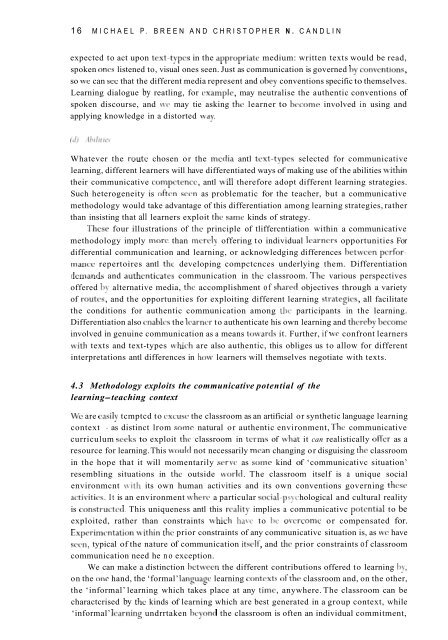Download - Search
Download - Search
Download - Search
You also want an ePaper? Increase the reach of your titles
YUMPU automatically turns print PDFs into web optimized ePapers that Google loves.
16 MICHAEL P. BREEN AND CHRISTOPHER N. CANDLINexpected to act upon text-types in the appropriatr medium: written texts would be read,spoken ones listened to, visual ones seen. Just as communication is governed I>y conventions,so we can see that the different media represent and obey conventions specific to themselves.Learning dialogue by reatling, for cxample, may neutralise the authentic conventions ofspoken discourse, and bve may tie asking thc learner to hccomc involved in using andapplying knowledge in a distorted \vay.Whatever the route chosen or the media antl tcxt-types selected for communicativelearning, different learners will have differentiated ways of making use of the abilities xvithintheir communicative compctence, antl \vi11 therefore adopt different learning strategies.Such heterogeneity is often secn as problematic for the teacher, but a communicativemethodology would take advantage of this differentiation among learning strategies, ratherthan insisting that all learners exploit the samc kinds of strategy.Thcse four illustrations of the principle of tliffercntiation within a communicativemethodology imply morc than merely offering to individual lcarncrs opportunities Fordifferential communication and learning, or acknowledging differences between pcrformanccrepertoires antl the developing compctcnces underlying them. Differentiationdemands and authcnticates communication in the classroom. The various perspectivesoffered by alternative media, the accomplishment of shared objectives through a varietyof routcs, and the opportunities for exploiting different learning strategics, all facilitatethe conditions for authentic communication among the participants in the learning.Differentiation also enahlcs the lcarner to authenticate his own learning and thcreby becomeinvolved in genuine communication as a means to\vartls it. Further, if ~ve confront learnerskvith texts and text-types lvhich are also authentic, this obliges us to allow for differentinterpretations antl differences in holv learners will themselves negotiate with texts.4.3 Methodology exploits the communicative potential of thelearning-teaching contextWe are easily tcmptcd to cxcuse the classroom as an artificial or synthetic language learningcontext ~ as distinct lrom somc natural or authentic environment, The communicativecurriculum sceks to exploit the classroom in terms of \vhat it can realistically offer as aresource for learning. This would not necessarily mean changing or disguising the classroomin the hope that it will momentarily servc as sonic kind of ‘communicativc situation’resembling situations in the outside \vorltl. The classroom itself is a unique socialenvironmcnt with its own human activities and its own conventions governing thescacti\itics. It is an environment where a particular social-p hological and cultural realityis constructcd. This uniqueness antl this rcality implies a communicativc potential to beexploited, rather than constraints lvhich haw to be overcome or compensated for.Experimcntation Lvithin the prior constraints of any communicativc situation is, as wc haveseen, typical of the nature of communication itself, and thc prior constraints of classroomcommunication need he no exception.We can make a distinction betwren the different contributions offered to learning by,on the one hand, the ‘formal’ language learning contexts ofthc classroom and, on the other,the ‘informal’ learning which takes place at any time, anywhere. The classroom can becharactcrised by the kinds of learning which are best generated in a group context, while‘informal’ lcarning undrrtaken beyond the classroom is often an individual commitment,


